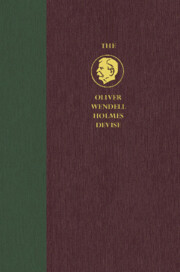Book contents
- The Hughes Court
- The Oliver Wendell Holmes Devise History of the Supreme Court of the United States
- Additional material
- Additional material
- The Hughes Court
- Copyright page
- Contents
- Acknowledgments
- Preface
- Table of Cases
- Introduction
- Part I The Opening Years
- Part II Continuities
- Section A: Administrative Law
- Section B: Civil Liberties and Civil Rights
- Section C: Justiciability
- Chapter 29 Basic Concepts of Justiciability
- Chapter 30 Sovereign Immunity and Political Questions
- Chapter 31 Regulating Access to the National Courts
- Chapter 32 Erie
- Chapter 33 Erie’s Legacy
- Chapter 34 Form and Style in Statutory Interpretation
- Part III New Approaches Begin to Emerge
- Historiographical Essay
- Index
Chapter 33 - Erie’s Legacy
from Section C: Justiciability
Published online by Cambridge University Press: 13 January 2022
- The Hughes Court
- The Oliver Wendell Holmes Devise History of the Supreme Court of the United States
- Additional material
- Additional material
- The Hughes Court
- Copyright page
- Contents
- Acknowledgments
- Preface
- Table of Cases
- Introduction
- Part I The Opening Years
- Part II Continuities
- Section A: Administrative Law
- Section B: Civil Liberties and Civil Rights
- Section C: Justiciability
- Chapter 29 Basic Concepts of Justiciability
- Chapter 30 Sovereign Immunity and Political Questions
- Chapter 31 Regulating Access to the National Courts
- Chapter 32 Erie
- Chapter 33 Erie’s Legacy
- Chapter 34 Form and Style in Statutory Interpretation
- Part III New Approaches Begin to Emerge
- Historiographical Essay
- Index
Summary
While Erie limited federal judicial power along one dimenions, it left many questions unresolved: How far did its rule extend? Were there still some special subjects about which the federal courts could develop a federal common law? What procedural rules governed the federal courts? Should the federal courts follow the choice-of-law rules in their states or develop an independent body of federal choice-of-law rules?The Court dealt with several of these questions in the years immediately after Erie. And it had to begin to interpret the reach of the Federal Rules of Civil Procedure, a code aimed at simplifying the rules regulating how litigation in the federal courts should proceed, adopted in 1937. In Sibbach v. Wilson the Court relied on a distinction between rules regulting procedure and those dealing with substance, and controversially held that an order directing that a litigant undergo a physical examination dealt with procedure rather than substance. It generally rejected constitutional challenges to state choice-of-law rules, and then held that Erie required the federal courts to follow the choice-of-law rules of the states in which they sat.
Keywords
- Type
- Chapter
- Information
- The Hughes CourtFrom Progressivism to Pluralism, 1930 to 1941, pp. 875 - 914Publisher: Cambridge University PressPrint publication year: 2022

